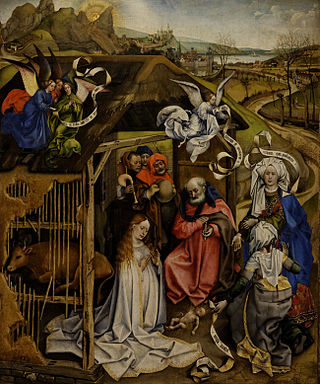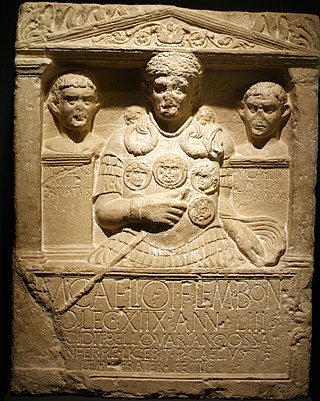A century is a period of 100 years or 10 decades. Centuries are numbered ordinally in English and many other languages. The word century comes from the Latin centum, meaning one hundred. Century is sometimes abbreviated as c.
Common Era (CE) and Before the Common Era (BCE) are year notations for the Gregorian calendar, the world's most widely used calendar era. Common Era and Before the Common Era are alternatives to the original Anno Domini (AD) and Before Christ (BC) notations used for the same calendar era. The two notation systems are numerically equivalent: "2024 CE" and "AD 2024" each describe the current year; "400 BCE" and "400 BC" are the same year.
An era is a span of time defined for the purposes of chronology or historiography, as in the regnal eras in the history of a given monarchy, a calendar era used for a given calendar, or the geological eras defined for the history of Earth.
The Julian calendar is a solar calendar of 365 days in every year with an additional leap day every fourth year. The Julian calendar is still used as a religious calendar in parts of the Eastern Orthodox Church and in parts of Oriental Orthodoxy as well as by the Amazigh people.

The Roman calendar was the calendar used by the Roman Kingdom and Roman Republic. Although the term is primarily used for Rome's pre-Julian calendars, it is often used inclusively of the Julian calendar established by the reforms of the Dictator Julius Caesar and Emperor Augustus in the late 1st century BC.

The 1st century was the century spanning AD 1 through AD 100 (C) according to the Julian calendar. It is often written as the 1st century AD or 1st century CE to distinguish it from the 1st century BC which preceded it. The 1st century is considered part of the Classical era, epoch, or historical period. The Roman Empire, Han China and the Parthian Persia were the most powerful and hegemonic states.
The 0s BC is the period between 9 BC and 1 BC, the last nine years of the before Christ era. It is one of two "0-to-9" decade-like timespans that contain nine years, along with the 0s.

Chronology is the science of arranging events in their order of occurrence in time. Consider, for example, the use of a timeline or sequence of events. It is also "the determination of the actual temporal sequence of past events".

This is a timeline of Afghan history, comprising important legal and territorial changes and political events in Afghanistan and its predecessor states. To read about the background to these events, see History of Afghanistan. See also the list of heads of state of Afghanistan and the list of years in Afghanistan.
A calendar era is the period of time elapsed since one epoch of a calendar and, if it exists, before the next one. For example, it is the year 2024 as per the Gregorian calendar, which numbers its years in the Western Christian era.
A decade is a period of ten years. Decades may describe any ten-year period, such as those of a person's life, or refer to specific groupings of calendar years.
The intercalary month or epagomenal days of the ancient Egyptian, Coptic, and Ethiopian calendars are a period of five days in common years and six days in leap years in addition to those calendars' 12 standard months, sometimes reckoned as their thirteenth month. They originated as a periodic measure to ensure that the heliacal rising of Sirius would occur in the 12th month of the Egyptian lunar calendar but became a regular feature of the civil calendar and its descendants. Coptic and Ethiopian leap days occur in the year preceding Julian and Gregorian leap years.
The Holocene calendar, also known as the Holocene Era or Human Era (HE), is a year numbering system that adds exactly 10,000 years to the currently dominant numbering scheme, placing its first year near the beginning of the Holocene geological epoch and the Neolithic Revolution, when humans shifted from a hunter-gatherer lifestyle to agriculture and fixed settlements. The current year by the Gregorian calendar, AD 2024, is 12024 HE in the Holocene calendar. The HE scheme was first proposed by Cesare Emiliani in 1993, though similar proposals to start a new calendar at the same date had been put forward decades earlier.

Oceanic art or Oceanian art comprises the creative works made by the native people of the Pacific Islands and Australia, including areas as far apart as Hawaii and Easter Island. Specifically it comprises the works of the two groups of people who settled the area, though during two different periods. They would in time however, come to interact and together reach even more remote islands. The area is often broken down into four separate regions: Micronesia, Melanesia, Polynesia and Australia. Australia, along with interior Melanesia (Papua), are populated by descendants of the first waves of human migrations into the region by Australo-Melanesians. Micronesia, Island Melanesia, and Polynesia, on the other hand, are descendants of later Austronesian voyagers who intermixed with native Australo-Melanesians; mostly via the Neolithic Lapita culture. All of the regions in later times would be greatly affected by western influence and colonization. In more recent times, the people of Oceania have found a greater appreciation of their region's artistic heritage.
The Gregorian calendar is the calendar used in most parts of the world. It went into effect in October 1582 following the papal bull Inter gravissimas issued by Pope Gregory XIII, which introduced it as a modification of, and replacement for, the Julian calendar. The principal change was to space leap years differently so as to make the average calendar year 365.2425 days long, more closely approximating the 365.2422-day 'tropical' or 'solar' year that is determined by the Earth's revolution around the Sun.
The proleptic Gregorian calendar is produced by extending the Gregorian calendar backward to the dates preceding its official introduction in 1582. In nations that adopted the Gregorian calendar after its official and first introduction, dates occurring in the interim period of 15 October 1582 to the date on which the pertinent nation adopted the Gregorian calendar and abandoned the Julian calendar are sometimes 'Gregorianized' also. For example, the birthday of U.S. President George Washington was originally dated 11 February 1731 because Great Britain, of which he was born a subject, used the Julian calendar and dated the beginning of English years as 25 March. After Great Britain switched to the Gregorian calendar, Washington's birthday was dated 22 February 1732 proleptically, according to the Gregorian calendar applied backward. This remains the modern dating of his birthday.

The Epic-Puranic chronology is a timeline of Hindu mythology based on the Itihasa and the Puranas. These texts have an authoritaive status in Indian tradition, and narrate cosmogeny, royal chronologies, myths and legendary events. The central dates here are the Kurukshetra War and the start of the Kali Yuga. The Epic-Puranic chronology is referred to by proponents of Indigenous Aryans to propose an earlier dating of the Vedic period, and the spread of Indo-European languages out of India, arguing that "the Indian civilization must be viewed as an unbroken tradition that goes back to the earliest period of the Sindhu-Sarasvati Valley traditions ."

The date of the birth of Jesus is not stated in the gospels or in any historical sources and the evidence is too incomplete to allow for consistent dating. However, most biblical scholars and ancient historians believe that his birth date is around 4 to 6 BC. Two main approaches have been used to estimate the year of the birth of Jesus: one based on the accounts in the Gospels of his birth with reference to King Herod's reign, and the other by subtracting his stated age of "about 30 years" when he began preaching.

The 0s began on January 1, AD 1 and ended on December 31, AD 9, covering the first nine years of the Common Era. It is one of two "0-to-9" decade-like timespans that contain nine years, along with the 0s BC.